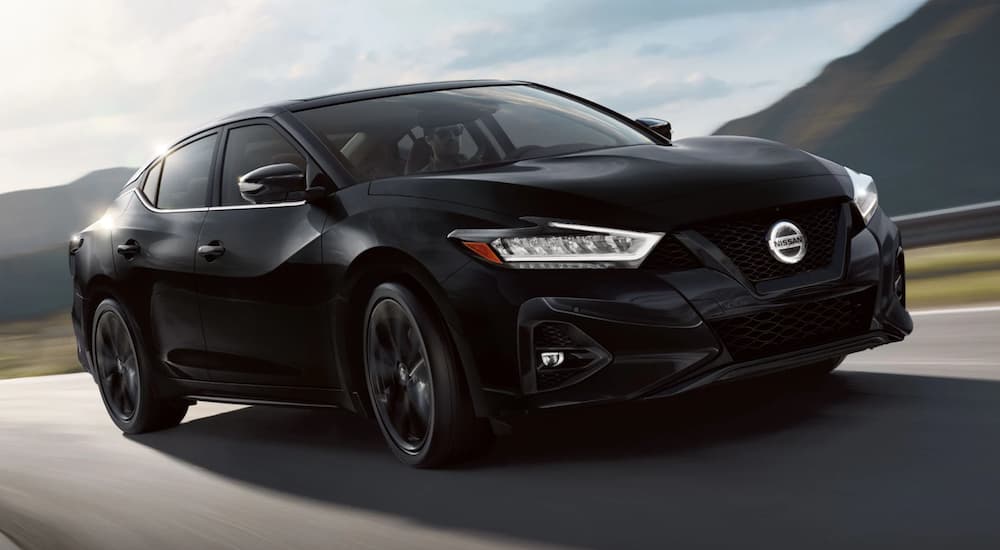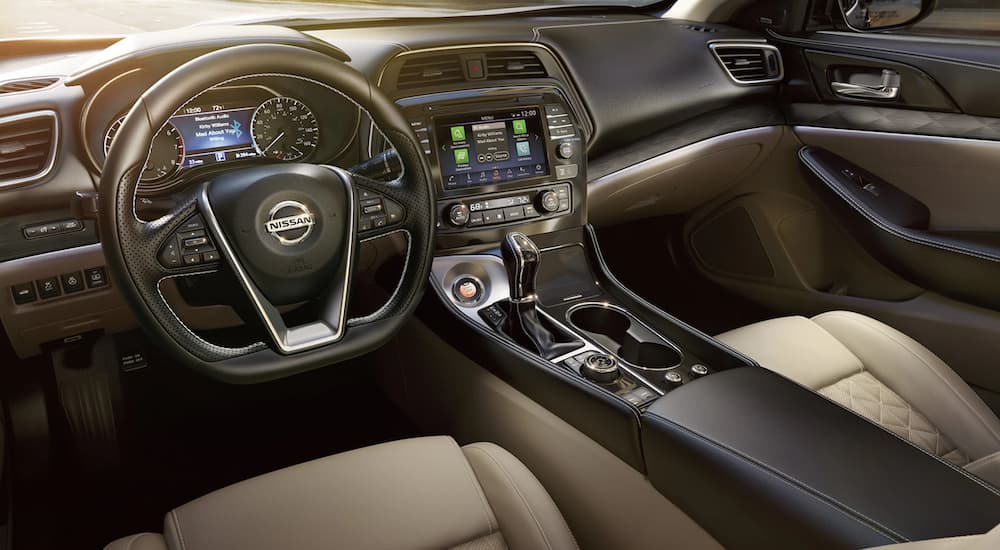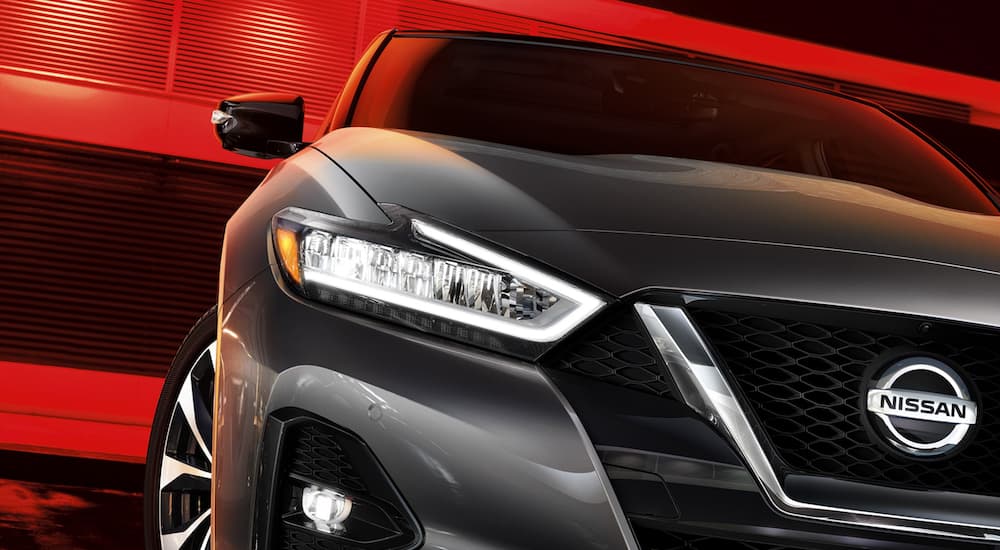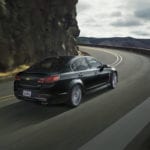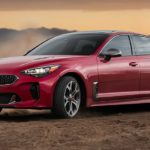Why do so many Americans idolize social media influencers? Perhaps it’s their knack for sniffing out the next big trend before it achieves mainstream popularity. Most of us lack the foresight to predict the next round of consumer products destined for what’s hot lists. Luckily, the latest trend resurrects a classic, known quantity: the sedan. Models like the 2022 Nissan Maxima are quickly replacing vanilla crossovers in driveways across America.
Longtime automotive experts wonder – why now? Everywhere you look, SUVs and crossovers dominate roadways. Even the newest EVs favor a crossover body style. Aren’t sedans a dying breed? Sure, sales numbers indicate waning demand for the sedan body style, but a closer look reveals an ever-so-slight uptick in aspirational interest, meaning would-be buyers are feeling excited about sedans again.
It makes sense. When was the last time you saw an 18 x 24 poster featuring a Ford Expedition tacked to a 12-year-old’s bedroom wall? That coveted real estate is reserved for Italian sports coupes and good old American muscle cars. The operative word is cars, not SUVs, because most of us don’t aspire to own a family-friendly SUV. So, back to our question: why now? What (and who) is behind the resurgence of interest in the sedan?
Japanese Automakers Never Wavered
It’s interesting that Ford and Chevy are winnowing sedans from their lineups, while automakers like Nissan and Toyota are investing engineering dollars in improving them. Models like the 2022 Maxima are better than ever, offering category-leading performance and surprisingly luxurious cabin appointments. The difference is especially glaring in a side-by-side comparison; one look at the Chevy Malibu, and descriptors like dull and ordinary come to mind. Juxtapose it with the sinewy Maxima, and the glaring differences are hard to miss.
Nissan is steadfast in its commitment to the sedan category. In a 2019 press release, the automaker announced its latest EV concept, the IMs, calling it an “elevated sports sedan.” The future-forward IMs could only manifest as a sedan, says Nissan, because to achieve its track-ready performance required a low drag coefficient. No offense to the Expedition, but sleek and aerodynamic it is not. The engineers at Nissan know that only a low-to-the-ground design can fully exploit the 483 horsepower and 590 lb-ft of torque produced by the concept’s dual electric motor powertrain.
While you won’t be seeing a Nissan IMs at the dealer anytime soon, available models like the Maxima benefit substantially from its essence. Consider the Maxima’s 300 horsepower V6 and selectable Sport drive mode that transforms the ride with access to more low-end torque. These driver-centric add-ons reflect the care with which Nissan builds its sedans. Meanwhile, the rental car-esque Malibu, currently in its ninth generation, hasn’t undergone a significant redesign since 2016, and even then, the only big change was an increase of four inches to its overall length.
Does Nissan know something Chevy doesn’t? Americans are bound to tire of the bulky crossover/SUV body style, yet sales numbers don’t lie. It’s clear that we still love our high-riding utes. We think Nissan is playing the long game. The lineup is prepped for a future that allows for both outcomes, but Nissan’s recent investment in its sedans portends a slow shift back to automotive homeostasis. Just as it was during the 1970s energy crisis, American automakers may have missed the boat.
The 1970s Energy Crisis: What Asian Automakers Did Right
Baby boomers remember sitting in the back of the family station wagon while Mom and Dad raged about long lines and rising prices at the gas pump. At its height, the 1970s energy crisis crippled the American economy. Petroleum shortages squeezed gas supplies at a time when Americans were driving massive Detroit gas guzzlers with big-block V8s that achieved paltry single-digit fuel economy ratings. Unfortunately, big, heavy muscle cars aren’t practical, a sad fact many drivers learned the hard way.
Chevy, Ford, and Chrysler – the Big 3 – weren’t convinced that these conditions would prompt buyers to demand more fuel-efficient cars, but for Japanese automakers looking to penetrate the elusive U.S. car market, that lack of foresight was the opening they needed. Enter Honda, Nissan, and Toyota. Companies like Honda tapped into years of experience manufacturing motorcycle engines and small profile vehicles, launching fuel-sipping cars like the Civic.
Nissan entered the market as Datsun, launching the wildly popular 240Z and the precursor to its iconic Sentra compact sedan, the Datsun 510. Nissan was also among the first manufacturers to produce a compact pickup truck, but the company’s bread-and-butter in its early days was the Z-car. Americans fed up with muscle car bulk embraced the Z-car’s sleek, aerodynamic profile and fun-to-drive characteristics. Today, many Z-cars fetch six figures on the classic car market, a testament to their lingering appeal.
The Maxima hit American dealerships as the Datsun 810 in the 1981 model year. Still fuel-efficient, it offered larger, more family-friendly proportions. The Maxima nomenclature was then just a trim, but eventually, it became the model’s primary name, and by 1984, Datsun was swapped out for Nissan. Currently in its eighth generation, the Maxima is Nissan’s flagship sedan. Offered in a simplified three-trim lineup for 2022, the Maxima earns accolades for its overall quality, value, and safety.
The Future of the Sedan
If you’re interested in learning what lies ahead for the four-door sedan, you’ll want to turn your attention away from Detroit. Ford has eliminated all cars from its lineup, and Chevy’s not far behind. Meanwhile, Nissan continues to offer five sedan models: the Versa, Sentra, Altima, Maxima, and the all-electric pioneer, the LEAF. Most models have recently undergone substantial redesigns, demonstrating even more concretely Nissan’s commitment to the sedan category.
The popular Altima sedan received a complete redesign in 2019, as did the subcompact Versa. Rumors continue circulating about an all-electric Maxima, but the company has yet to confirm them. Only aficionados know that the Z-car is still alive and well in the Nissan lineup. The go-fast coupe has anchored the lineup for half a century, with the latest version – the 370Z – selling out in record time. Even more scuttlebutt surrounds the future of Nissan’s sporty Z-car, but most insiders agree the nameplate isn’t being retired. Who knows, it may even find its way onto a sedan. Stranger things have happened (Mustang Mach-E, anyone?).
For now, we recommend adding a sedan like the Maxima to your consideration set if you’re even one percent tired of SUVs. Forget about trends and focus on ride handling and maneuverability. As for passenger volume, most crossovers and SUVs only seat five passengers. Excluding large families or buyers who simply prefer a bigger vehicle, most potential crossover buyers will find similar utility in a sedan. And, trust us – they’re way more fun to drive.
As for the Maxima, details about the IMs concept EV seem to have some overlap with the buzz surrounding an electrified Maxima. Are they one and the same? Only time will tell, but it’s more than a possibility. Nissan’s three engineering pillars, collectively called Nissan Intelligent Mobility, are on full display with the IMs. Its next-generation autonomous driving capability and over-the-air connectivity exemplify Nissan’s utopian plans for a “sustainable mobile society.” How fitting if the Maxima led the effort.
Sedans Are Back (Trust Us)
We may not be bonafide influencers, but our money’s on a big return of the sedan. Rising gas prices and climate change necessitate more fuel-efficient (or fuel-free) engine technologies, and while many buyers will continue their love affair with SUVs and pickup trucks, we believe the sedan category will see a substantial boost in the coming years. Does that mean Ford and Chevy have once again failed to read the tea leaves? Their lineups speak volumes.
If a new vehicle is in your future, consider revisiting the sedan. Chances are it’s been a while since you took the wheel of a low-riding four-door, so prepare yourself for a wave of nostalgia. A closer look at many “trends” reveals not that they’re new: in most cases, they’re revived from earlier decades. Bell bottom jeans, scrunchies, and puffy sleeves weren’t invented in the aughts, after all. To the sedan, we say, welcome back to the mainstream.
